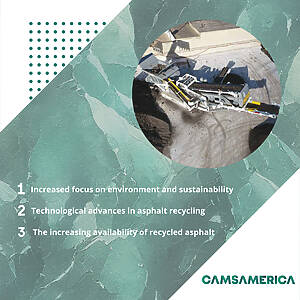Roads are one of the most important infrastructures of the modern era, providing mobility and connectivity to millions of people every day. The choice of material to be used for the design and construction of road paving therefore becomes crucial, with long-term environmental, economic and social implications. But what are the main differences and the pros and cons of traditional asphalt and recycled asphalt?
Traditional asphalt
Traditional asphalt is produced using virgin materials, such as bitumen, aggregates and filler. This material offers a number of advantages:
- Resistance: Traditional asphalt is a durable and weatherproof material.
- Durability: Traditional asphalt can last decades if properly maintained.
- Maintenance: Traditional asphalt is relatively easy to repair and maintain.
However, the production of traditional asphalt also has a number of drawbacks to consider
- Environmental impact: producing traditional asphalt requires the extraction of natural resources, such as bitumen and aggregates, and produces greenhouse gas emissions.
- Cost: Traditional asphalt is an expensive material to produce.
Recycled asphalt
Recycled asphalt is produced using recycled materials such as milled asphalt or bitumen recovered from old abandoned road surfaces.
Recycled asphalt offers a number of advantages, including:
- Low environmental impact: The use of recycled asphalt has been shown to reduce greenhouse gas emissions by about 20% compared to traditional asphalt. The use of this material also significantly reduces the use of raw materials.
- Cost savings: Recycled asphalt can be cheaper than traditional asphalt because it can reduce road production and maintenance costs by about 10% compared to traditional asphalt.
- Quality and durability: modern recycling technologies allow us to produce recycled asphalt that meets high quality standards and road life.
However, the use of recycled asphalt could present some problems such as:
- Availability: Availability of recycled asphalt can be limited, especially in areas with low traffic volume
- Quality: The quality of recycled asphalt can vary depending on the source of the recycled material.
The current situation in the United States
In the debate comparing traditional and recycled asphalt, these data regarding the use of recycled asphalt in the United States are of particular interest:
- The use of recycled asphalt in the United States can reduce greenhouse gas emissions by about 10 million tons of CO2 per year
- Using recycled asphalt in the United States can reduce road production and maintenance costs by about $5 billion a year.
According to the National Asphalt Pavement Association (NAPA), asphalt recycling in the United States is growing at a rate of 10% per year. This growth is driven by a number of factors, including:

NAPA also predicts that asphalt recycling in the United States will reach 30% of total production by 2030.
Here are some concrete examples of using recycled asphalt in the United States:
- In 2022, the California Department of Transportation used 100% recycled asphalt for the construction of a new stretch of highway in Los Angeles.
- In 2023, the Texas Department of Transportation announced a plan to use 20% of recycled asphalt in all of its road construction projects.
- In 2024, the city of New York announced a plan to use 30% of recycled asphalt in all of its road repair projects.
An eye to the future
Recycled asphalt is a sustainable and advantageous solution for road paving. Its large-scale adoption is growing and will help reduce the environmental impact of the road construction industry in the coming decades.
This commitment to sustainability demonstrates the fundamental role of companies such as CAMSAMERICA, always active in promoting innovative and environmentally friendly solutions, helping to build a future with eco-sustainable infrastructure; as we often say: “the roads of the future are green”!





